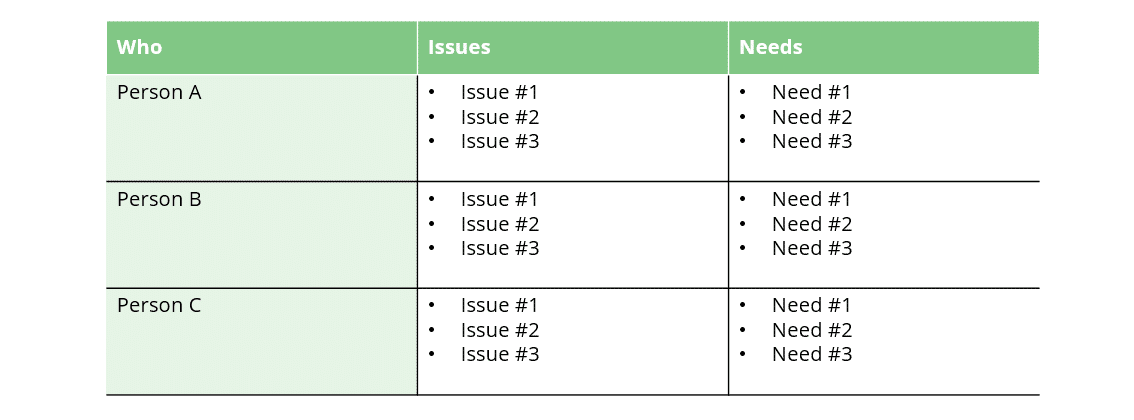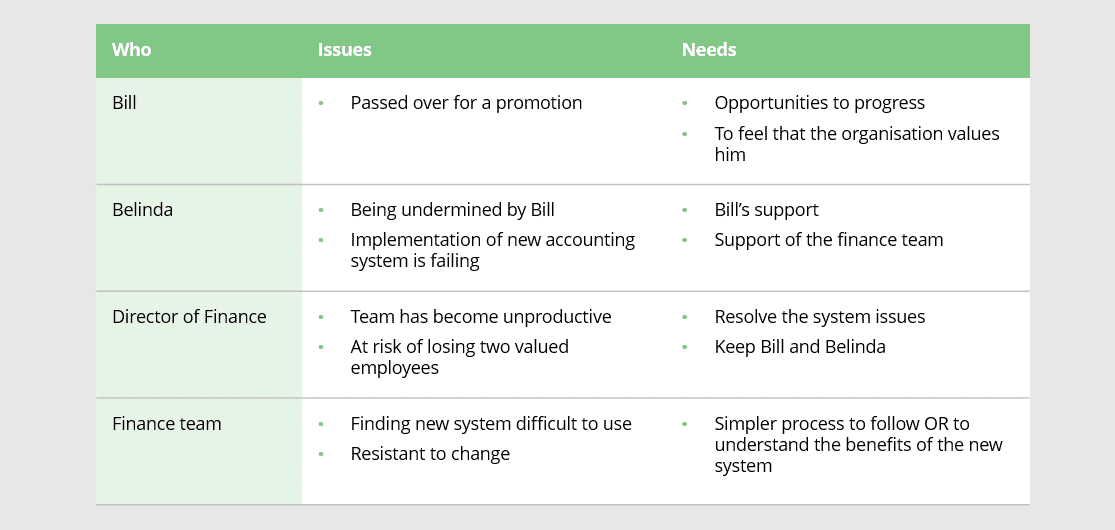Mapping a conflict
- Guides
- Conflict management
- Mapping a conflict
Mapping the conflict is about documenting (mapping) the different needs and perspectives of the parties involved in the conflict. This allows you to see the conflict from all angles and helps you to develop better solutions.
Mapping is a useful exercise if you are faced with a complex conflict situation (e.g. lots of stakeholders / lots of needs to consider), a volatile situation where the parties have reached a stalemate, or you just want to get a better understanding of the conflict.
How to map a conflict
- Have individual discussions with each person involved in the conflict to identify their issues and their needs. Ask them the following questions; What do you see as the underlying issues? What do you need to move forward?
- Document the answers to these questions in a conflict ‘map’ (see below).

Conflict example
Bill has been working for Petra Co. in the QLD office for the last 10 years. He is a highly valued employee of the finance team and has often travelled to the head office in Sydney to attend training and meetings.
Recently, the role of finance manager became available within QLD. Bill had stepped into this role in an acting duty for the last 3 months. Although Bill does not have any formal qualifications, he does understand the requirements of the job perfectly and is well-liked by the other employees in his department for his easy going and friendly approach. Bill had viewed this as his opportunity to finally step into a senior role, however, the Director of Finance in Sydney decided to appoint a person from outside the business, despite Bill applying for the role.
Belinda, the new Finance Manager, has a degree in finance and a good track record in similar roles in previous organisations. She prides herself on efficiency and her ability to make sure a job is well done. Belinda recently implemented a new accounting system to improve the service and reporting of the finance team. The new system has not worked out too well as it requires the users to be punctual with their duties. If someone fails to do one or two steps on the required day, the whole system tips over. Belinda is now finding that the team are making a lot of mistakes and they have slowed down even further in the way they do things. Paperwork is not completed properly, problems are not being solved quickly, and general invoicing and the following up of debtors has become inefficient.
Belinda is feeling a little down about the whole situation. She feels that she has been at a disadvantage since she joined the organisation. Every change she has introduced has been a battle and not supported at all by the team, especially Bill.
Behind the scenes, Bill is quietly undermining Belinda with the team, as he believes he should have been given the job. He is very unhappy and thinking of leaving, but at the same time he wants to stand his ground as he feels he knows more than Belinda. Bill can’t understand all the hurry to change everything, it was working just fine the way things were. The Director of Finance in Sydney sees value in both of these employees and does not want to lose either of them.

Possible actions to resolve the issues...
- Talk to Bill about why he was passed over for the promotion. Work with him to look at other opportunities for career advancement.
- Address Bill’s undermining of Belinda and explain that it is not acceptable.
- Meet with Belinda and the finance team (including Bill) and try to diagnose the underlying issues for the finance team not adopting the new system. Ensure that they know you fully support the new initiative.
Learn more
Next: Module resources